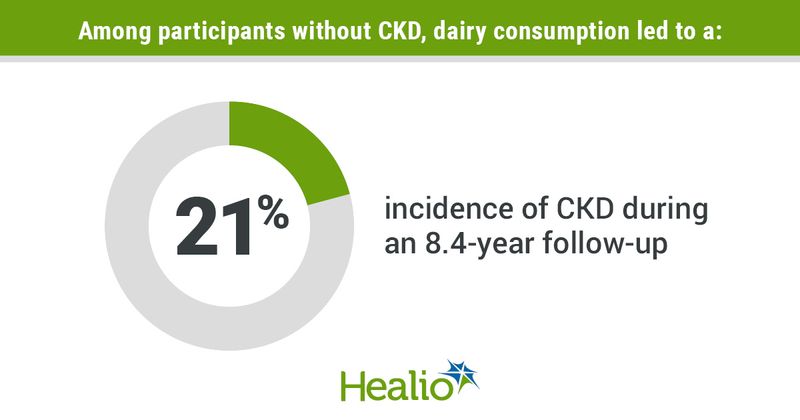Greater high-fat dairy, high-fat milk consumption may reduce risk of CKD
Among people without chronic kidney disease, consuming a greater amount of high-fat dairy or high-fat milk corresponded with a lower risk of CKD, according to data published in the Journal of Renal Nutrition.
Further, consuming other dairy products did not cause an increased risk of CKD.

“Among dietary risk factors, the role of dietary protein in renal dysfunction has been debated for decades. Most clinical guidelines recommend restricting protein intake in CKD to prevent increased glomerular pressure and hyperfiltration. However, little is known about the role of different dietary protein sources on renal function,” Parvin Mirmiran, PhD, from the Nutrition and Endocrine Research Center in the Research Institute for Endocrine Sciences at Shahid Beheshti University of Medical Sciences in Iran, and colleagues wrote. They added, “Since there is limited data regarding the association between dairy intake and incidence of CKD, and because available studies did not investigate the effect of each subgroup of dairy products on CKD, we aimed to study the potential association between dairy products intake and the risk of CKD and to determine whether the association could be influenced by the fat content and/or subtypes of dairy products.”
Within the Tehran Lipid and Glucose Study (TLGS), an ongoing prospective study, researchers examined 2,416 adults without CKD (mean age was 38 years; 46% were men) living in Iran who have been monitored every 3 years since 1999. Participants completed a validated 168-items semi-quantitative food frequency questionnaire and reported their intake frequency for each item consumed on a daily, weekly or monthly basis. The items included milk (low-fat milk, high-fat milk and chocolate milk), yogurt (low-fat yogurt and high-fat yogurt), regular cheese (traditional Iranian cheese and feta cheese), cream cheese and ice cream.
Researchers converted frequencies into daily intakes and portion sizes for analyses. Similarly, researchers categorized dairy products as low-fat dairy (including low-fat milk, low-fat yogurt and regular cheese) and high-fat dairy (high-fat milk, chocolate milk, high-fat yogurt, cream cheese and ice cream), as well as fermented (low- and high-fat yogurt, regular and cream cheese) and non-fermented dairy products (low- and high-fat milk and ice cream). The eGFR of participants was measured using the Chronic Kidney Disease Epidemiology Collaboration creatinine equation. Using multivariable Cox regression, researchers determined CKD risk when substituting total dairy with other dietary protein sources.
Overall, the incidence of CKD was 21% during 8.4 years of follow-up. Analyses revealed no association of dietary intakes of total dairy, low-fat dairy and fermented dairy with CKD risk. Further, no correlation was seen between substitutions of total dairy with other dietary protein sources and CKD incidence. However, compared with low-fat dairy and low-fat milk intake, there was a significantly lower risk of CKD associated with high-fat dairy and high-fat milk consumption.
Mirmiran and colleagues concluded, “Considering the protective associations observed between high-fat dairy and high-fat milk and risk of CKD, and inconsistent findings of previous studies, further prospective cohort and clinical trials are suggested to clarify the potential health effects of high-fat dairy products, and if necessary, reconsideration of dietary guidelines regarding consumption of high-fat dairy products.”
